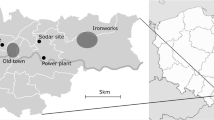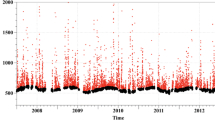Abstract
Atmospheric mixing ratios of chlorinated C1 and C2 hydrocarbons (CHCs) were measured at the mountain Wank (Garmisch-Partenkirchen, Bavarian Alps) in autumn 1992. The data lead to the assumption that at least part of the observed CC14 originates from a source different to the other CHCs measured (C2HCL3, C2C14, CHCl3 and CH3CCl3). The nature of this source is discussed.
Similar content being viewed by others
References
Lovelock J.E., Maggs R.J. &Wade R.J. (1973) Halogenated hydrocarbons in and over the Atlantic. Nature 241, 194–196
Warneck P. (1988) Chemistry of the natural atmosphere. Internat. Geophysics Series Vol. 41, Acad. Press Inc., San Diego, Calif.
Naumann K. (1993) Chlorchemie der Natur. Chemie in unserer Zeit 27/1, 33–41
Wallace D.W.R., Beining P. &Putzka A. (1994) Carbon tetrachloride and chlorofluorocarbons in the South Atlantic Ocean, 19°S. J. Geophys. Res. 99/C4, 7803–7819
Class Th. &Ballschmiter K. (1987) Chemistry of organic traces in air — IX. evidence of natural marine sources for chloroform in regions of high primary production. Fresenius’ Z. Anal. Chem. 327, 40–41
Frank H., Frank W. &Neves H.J.C. (1991) Airborne C1 and C2 halocarbons at four representative rites in Europe. Atmos. Environ. 25A, 257–261
Weigb A. (1993) Atmospheric mixing ratios of several chlorinated hydrocarbons at the mountain „Wank“ near Garmisch-Partenkirchen. Proceedings of the 2nd IMTOX-Workshop, 1–11
Isidorov V.A., Zenkevich I.G. &Ioffe B.V. (1990) Volatile organic compounde in solfataric gases. J. Atmos. Chem. 10, 329–340
Rippen (1992) Handbuch der Umweltchemikalien. 15. Erg. Lfg. 5/92, Ecomed Landsberg, Germany
Materne B. (1989) Aliphatische Chlorkohlenwasserstoffe. Ecomed Landsberg, Germany
Prather M. (1988) European sources of halocarbons and nitrous oxide: Update 1986. J. Atmos. Chem. 6, 375–406
Singh H.B., Lillian D., Appleby A. &Lobban L. (1975) Atmospheric formation of carbon tetrachloride from tetrachloroethylene. Envir. Lett. 10, 253–256
Penkett S.A., Brice K.A., Derwent R.G. &Eggleton A.E.J. (1979) Measurement of CC13 F and CC14 at Harwell over the period January 1975 — November 1977. Atmos. Environ. 13, 1011–1019
Author information
Authors and Affiliations
Rights and permissions
About this article
Cite this article
Weiß, A. Sources of airborne CC14 . Environ. Sci. & Pollut. Res. 3, 112–114 (1996). https://doi.org/10.1007/BF02985505
Issue Date:
DOI: https://doi.org/10.1007/BF02985505




